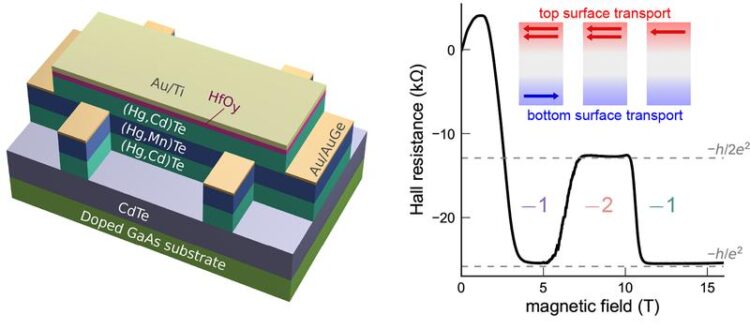Parity Anomaly Demonstrated in a Topological Insulator

The figure shows a schematic of the device used in the experiment. The re-entrant quantum Hall effect, where the electrical resistance goes back and forth when the magnetic field is increased, is a signature of the parity anomaly.
(c) Dr. Li-Xian Wang / University of Würzburg
Experimental and theoretical physicists from the Würzburg Institute for Topological Insulators observed a re-entrant quantum Hall effect in a mercury telluride device and identify it as a signature of parity anomaly.
Topological insulators are materials that can conduct electricity, but only on their surface or edges. No current flows inside them. They are the subject of intensive research worldwide because they have unique electronic properties that are interesting for improving the efficiency of quantum computers, for example, and for other technologies such as encryption and the secure transmission of data.
In the journal Advanced Science, researchers from the Institute for Topological Insulators and the Institute for Theoretical Physics and Astronomy at Julius-Maximilians-Universität Würzburg (JMU), now present an unusual quantum Hall effect that was observed on a microscopic device made of the topological insulator material mercury telluride (HgTe).
Clear Experimental Observation
In the mercury telluride device, electrons at the top and bottom surfaces behave as relativistic Dirac particles. As predicted, but not experimentally verified by particle physics, Dirac particles should be subject to the so-called parity anomaly. In solid-state experiments, the parity anomaly leads to an effect called spectral asymmetry, that can be measured as an unusual change in the electrical resistance.
“The parity anomaly has been predicted to occur in solid state materials since the 1980s. A famous theoretical proposal is the model proposed by Haldane (Nobel Prize in Physics in 2016). We have identified another consequence of the parity anomaly which is the first one to be experimentally verified,” says Professor Ewelina Hankiewicz.
Effect is not Specific to Just Mercury Telluride
The JMU physicists have realised this two-dimensional Dirac physics on a single surface of the three-dimensional topological insulator. “We observe an unconventional re-entrant quantum Hall effect that can be directly related to the occurrence of spectral asymmetry in a single topological surface state. The effect is generic for any topological insulator, not specific to just mercury telluride. The universality of the result is what makes it so exciting,” says Dr. Wouter Beugeling.
Two challenges had to be overcome for these new findings. Firstly, the signature of spectral asymmetry had to be identified among the other features in the measured electrical resistance. Secondly, the device had to be controlled in such a way that the effects from the two surfaces did not cancel each other.
High Level of Control Allows Further Explorations
“This observation shows that with the high level of control we have in this device allows us to explore many more interesting aspects of topological insulator physics than before,” says Professor Laurens Molenkamp.
A key factor in achieving the experimental accuracy required for this observation was the high quality of the HgTe material, which was produced in the molecular beam epitaxy facility at the Würzburg Institute of Physics. Molecular beam epitaxy (MBE) is a technique for producing wafer-thin layers of material with customised electronic, optical and magnetic properties. With MBE, layer structures can be precisely built up atom layer by atom layer.
Cluster of Excellence ct.qmat
The authors of the publication participate in the Cluster of Excellence ct.qmat – Complexity and Topology in Quantum Matter, which has been jointly run by Julius-Maximilians-Universität (JMU) Würzburg and Technische Universität (TU) Dresden since 2019. ct.qmat is funded through the German Excellence Strategy of the Federal and State Governments.
Wissenschaftliche Ansprechpartner:
Dr. Wouter Beugeling, wouter.beugeling@physik.uni-wuerzburg.de
Originalpublikation:
Spectral asymmetry induces a re-entrant quantum Hall effect in a topological insulator. Li-Xian Wang, Wouter Beugeling, Fabian Schmitt, Lukas Lunczer, Julian-Benedikt Mayer, Hartmut Buhmann, Ewelina M. Hankiewicz, and Laurens W. Molenkamp. Advanced Science, early view 13 March 2024, DOI: 10.1002/advs.202307447, Open Access: https://onlinelibrary.wiley.com/doi/10.1002/advs.202307447
Media Contact
All latest news from the category: Physics and Astronomy
This area deals with the fundamental laws and building blocks of nature and how they interact, the properties and the behavior of matter, and research into space and time and their structures.
innovations-report provides in-depth reports and articles on subjects such as astrophysics, laser technologies, nuclear, quantum, particle and solid-state physics, nanotechnologies, planetary research and findings (Mars, Venus) and developments related to the Hubble Telescope.
Newest articles
Faster, more energy-efficient way to manufacture an industrially important chemical
Zirconium combined with silicon nitride enhances the conversion of propane — present in natural gas — needed to create in-demand plastic, polypropylene. Polypropylene is a common type of plastic found…

Energy planning in Ghana as a role model for the world
Improving the resilience of energy systems in the Global South. What criteria should we use to better plan for resilient energy systems? How do socio-economic, technical and climate change related…

Artificial blood vessels could improve heart bypass outcomes
Artificial blood vessels could improve heart bypass outcomes. 3D-printed blood vessels, which closely mimic the properties of human veins, could transform the treatment of cardiovascular diseases. Strong, flexible, gel-like tubes…





















